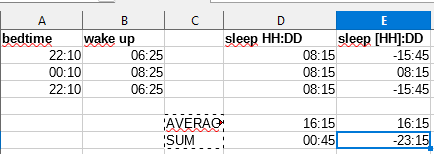I have a column of time spans. For example
8:45:06
12:35:45
etc
I’d like to determine the average time span. Like, what is the average amount of hours I spent doing X each day. Not what average time I started X (although I have that data) but time spent.
=AVERAGE(A1:A2) gives 0.
=AVERAGE(A1:A2)/24 gives #DIV/0! (read here about how spreadsheets see time as % of days vs hours)
=SUM((A1:A2)/2 gives 0 (this is the formula used for the other columns that are just numbers)
Numbers are formated as time 00:00:00 without the PM because it isn’t a clock time but an amount of time.
Surely I don’t have to do /24 for each entry. That would be time consuming. And I’d have to do another average listing. 




